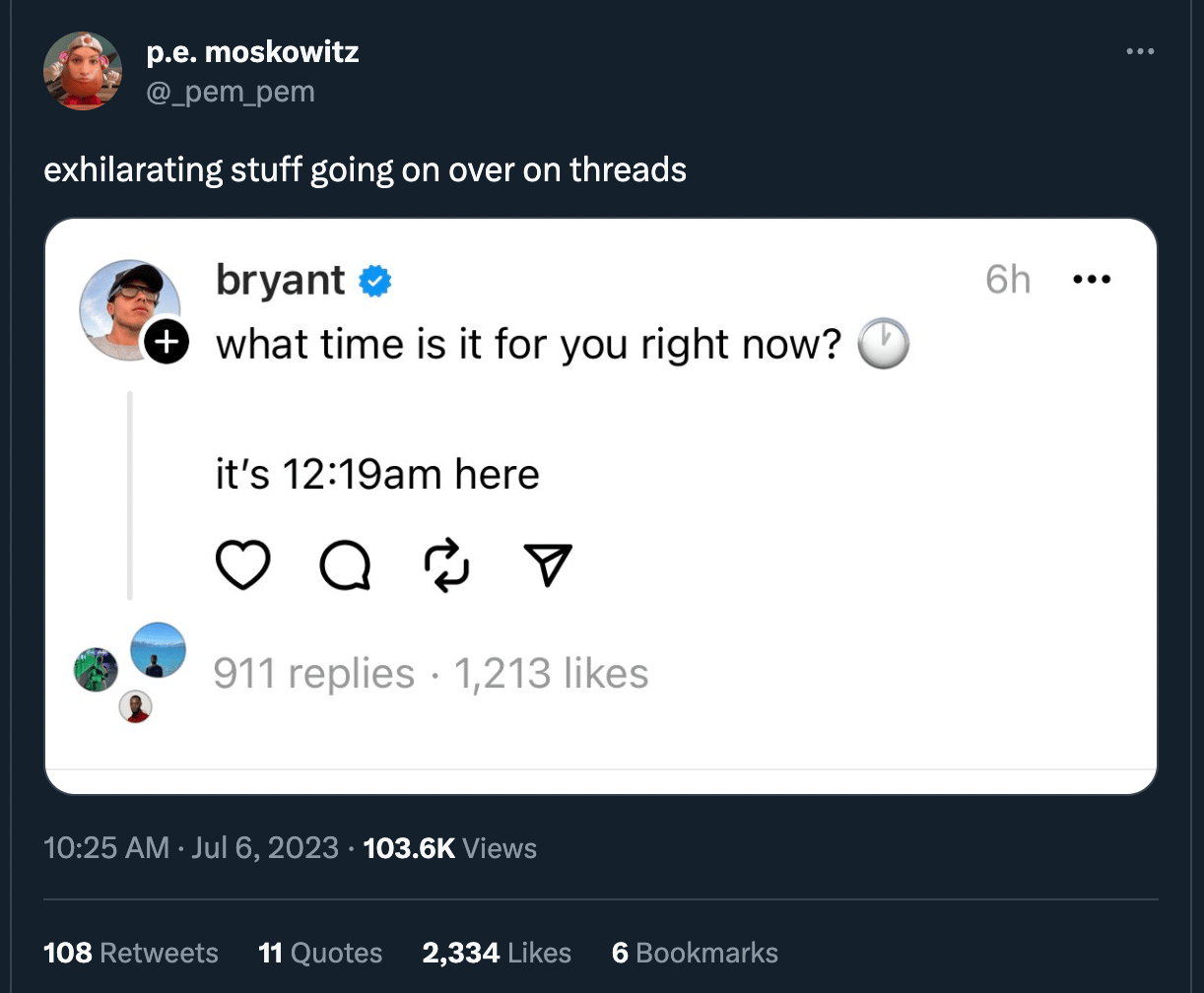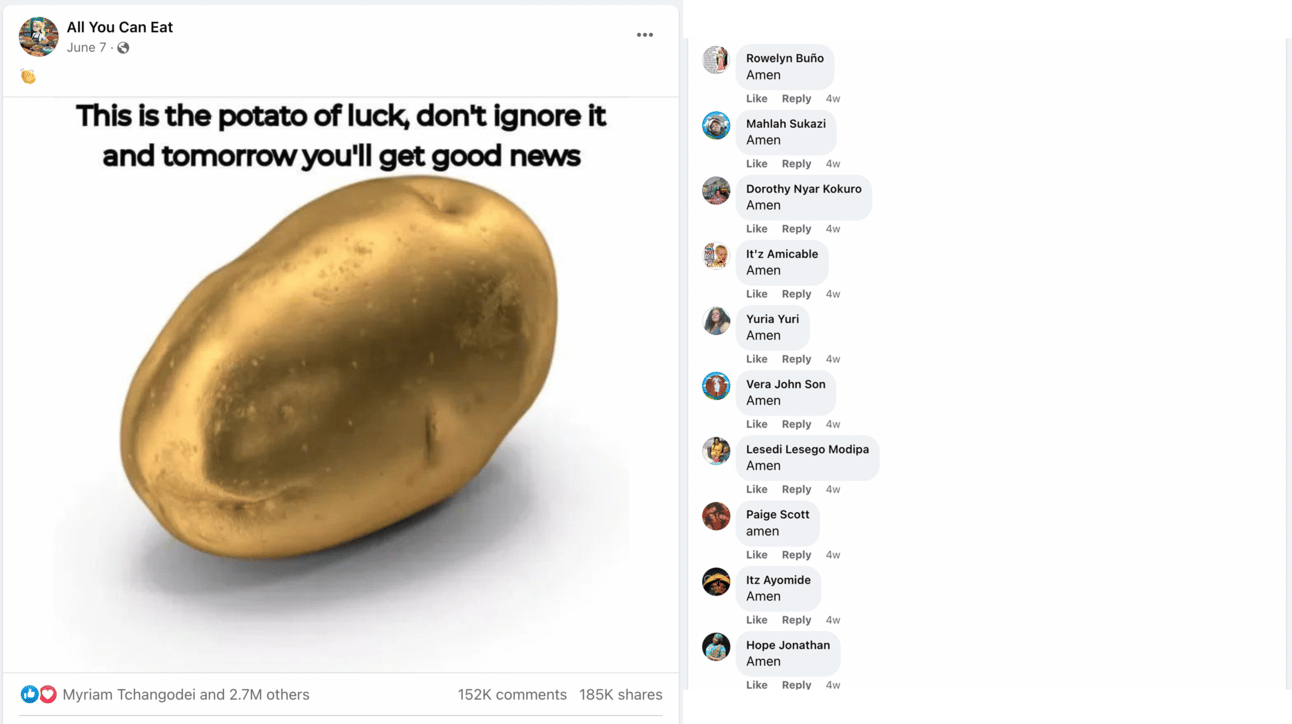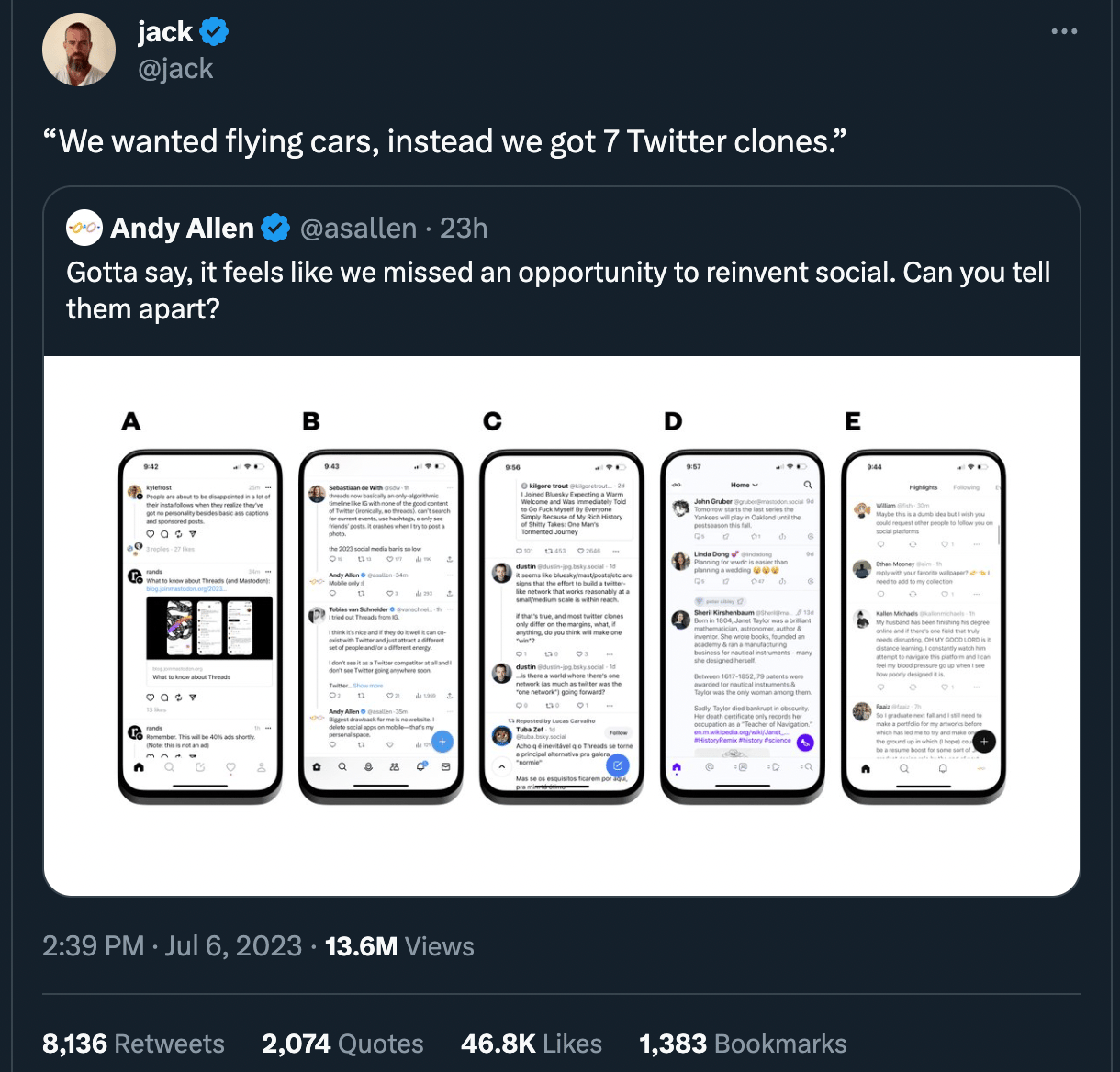When I first opened Meta’s new Threads app on Wednesday night I was extremely excited for a very brief second. I hadn’t followed anyone yet, but my feed was already full of content. I initially thought they had just opened the floodgates and put everyone in the same feed together. The Bluesky Hellthread as an app. I quickly realized that wasn’t what was happening and that, in fact, Threads was running on an algorithm similar, if not identical, to Instagram’s. And that’s when I became deeply depressed. But I also realized I had a unique opportunity.
I decided not to follow anyone. And so, for the last couple days, I have only been seeing the raw machinery of Threads. Its algorithm is just blasting me with random posts and, every so often, it tries to show me more of a particular user I click on or spend too long reading in the feed.
My verdict: Threads sucks shit. It has no purpose. It is for no one. It launched as a content graveyard and will assuredly only become more of one over time. It’s iFunny for people who miss The Ellen Show. It has a distinct celebrities-making-videos-during-COVID-lockdown vibe. It feels like a 90s-themed office party organized by a human resources department. And my theory, after staring into its dark heart for several days, is that it was never meant to “beat” Twitter — regardless of what Zuckerberg has been tweeting. Threads’ true purpose was to act as a fresh coat of paint for Instagram’s code in the hopes it might make the network relevant again. And Threads is also proof that Meta, even after all these years, still has no other ambition aside from scale.

But let’s start at the beginning. Myspace launches in 2003 and it quickly makes the idea of a social network mainstream. Facebook goes live exclusively for users with college email addresses a year later. Facebook’s News Feed, which turns the platform into something beyond just a Myspace for rich kids, turns on in 2006. Myspace use peaks in 2008. Facebook overtakes it in 2009. The chronological News Feed is phased out in 2011. The algorithmic era begins.
Twitter, on the other hand, comes from an entirely different evolutionary branch. It launches in 2006 as a place for nerds to eventually complain about Google Glass discrimination and for much of its early years it largely exists as a complimentary service to Google Reader. Its earliest users were bloggers and journalists using it to syndicate stories. The earliest concept of “Black Twitter,” which The Awl described as “Late Night Black People Twitter,” appears in 2009. “Weird Twitter,” a collection of Something Awful goons and semi-leftist shitposters, is recognized as a subculture in 2012. In 2013, Justine Sacco posts the AIDS tweet. And, finally, the #Gamergate hashtag starts in 2014.
And for the last decade, we have basically had these two digital spheres — Facebook’s relatively safe algorithmic walled garden or the sociopolitical Hunger Games of Twitter. Except, Twitter would be the one to go on to gain such jaw-dropping levels of cultural importance that an entire presidency was run on it. Meanwhile, Facebook grew both in users and affiliated apps, but retreated up the asshole of its own algorithm. Case in point: Last spring, Elon Musk and the weird freaks in his group chat became so obsessed with Twitter that Musk agreed to acquire it for $44 billion. And the biggest Facebook page in the US at the time was livestreaming bingo.
In retrospect, it seems like Jack Dorsey and his, what I like to call, “Burning Man libertarianism” approach to content moderation, was the real secret sauce to Twitter’s cultural cachet from 2015-2021. He was able to balance enough plates with a deft enough hand to keep all the disparate parts of the app in place. You could watch porn. Its hashtags could topple governments. Minorities could put pressure on society’s power structures. Rich people could feel like celebrities and celebrities could feel like artists. And, most importantly, it created a lot of really good memes. Even if everyone was completely miserable. Facebook, over the same stretch of time, became a place for old people to share Ring camera footage and haggle over used furniture. I discovered while putting together this month’s Garbage Intelligence trend report that the fourth-most interacted with Facebook post in June was a picture of a potato shared by an Amazon dropshipping page that users were writing “Amen” underneath.

And now we have Threads. Meta clearly dusted off their “kill Snapchat” playbook to launch it because, just as they did with ephemeral stories in 2016, Meta has taken the surface-level components of a competitor’s platform and ported them over to their network and retrofitted them to run on their algorithm. Comparing Meta to the Borg from Star Trek implies a level of sophistication I don’t think they deserve. Comedy writer Jason O. Gilbert came closer to nailing it, writing this week that, “Threads feels like when a local restaurant you enjoy opens a location in an airport.”
Instagram head Adam Mosseri said that Threads’ algorithm is primarily about discovery. “We do rank posts lightly and show recommendations (posts from accounts you don't follow) in feed, which is particularly important for a new app before people follow enough accounts,” he posted this week. (And a chronological feed is reportedly coming.) Though, I’d put all of this another way: Meta’s algorithms are automated digital gentrification. And the only good thing about Threads is that its largely text-based interface gives us the clearest look yet at how all of Meta’s apps work.
Without followers, Threads’ algorithm continues to only show me users that crawled out of the bizarre netherworld of Meta celebrity. They host podcasts you’ve ever heard of, have small roles on TV shows that don’t appear to actually exist, and share videos that went viral on Reddit four months ago with captions like “omg who did this.” Over the years, I’ve managed to meet a handful of these content creators, ones that decided to solely focus on Meta products. All of them eventually end up producing the same anti-culture nothingness that does well on Facebook or Instagram or, now, Threads. They have millions of “followers,” and yet nothing they create goes anywhere or matters in any tangible sense. It’s like watching two large cryptocurrencies trade with each other. No cultural value is ever really generated, but the numbers go up. And these creators all operate with a nervous intensity that feels almost biblical, constantly jumping to and from recycled trends, hoping to please a finicky and vengeful god that treats them like an invasive species. And, save only a few, most of the Meta creators I’ve met seem to, in return, deeply loathe the content they make, the people who like it, and Meta, itself.
As for Threads’ interface, it’s also bad. Though, I’m hesitant to spend too much time thinking about it. Meta usually figures out how to make their apps convenient, if nothing else.
That said, the reported 30 million users that joined Threads this week all clearly came over from Instagram and don’t know that they can share or “rethread” anything. I’m not even sure the app shows the metric on the main feed. Not that there’s anything worth sharing there in the first place. Also, its notifications tab is a mess that flattens everything into one pointless interaction number on your phone and makes following anyone back or having a coherent conversation with them a huge headache. It also has Instagram’s extremely draconian moderation policies.
Of course, none of that is an accident. It’s not for us.
As Coin Center spokesperson Neeraj Agrawal put it, “it's a top down mass market tool for brands.” In fact, more than few users screenshot the exact same group of branded posts in the exact same order that I saw this week, as well. They were waiting for us.

My guiding theory has been that neither Bluesky or Threads will end up killing Twitter. That this whole race to build a new Twitter will just result in a bunch of increasingly-smaller versions of the same app, used by different groups. Nothing I’ve seen from Threads this week has convinced otherwise. But I do think it’s worth pointing out the scale already at play here.
As of last year, Twitter had around 350 million users. Threads, in its first week, has 30 million. And the most-followed account on Bluesky is the official Bluesky account, which has about 54,000 followers. Of course, Bluesky is still invite-only, but it seems extremely silly to think that these sites are comparable at the moment.
But I’ll leave you with this. If you look back at every era of the internet, towards the end of each, you’ll see a whole pile-up of forgotten apps that tried to swoop in and bring back or replace something that was dying or dead. Myspace tried to bounce back with a redesign. Vine was going to be resurrected as Byte. BeReal was marketed as a way to recapture the simple fun of Snapchat, etc. But it doesn’t really work that way. Our tastes change. We move on. And then suddenly we can’t imagine ever going back.
As Rest Of World’s Caiwei Chen pointed out this week, TikTok’s Threads-like Twitter alternative Lemon8 launched in the US in February and quickly rocketed to the top of the App store. It has since devolved into a wasteland in the ensuing months. (Have you even heard of it?) Which makes me think that there’s little reason for users from a TikTok-like app to ever need a Twitter-like app.
So if Threads does work, it won’t be because it has toppled Twitter, but because it toppled Instagram. And there’s no reason to think it couldn’t — it supports a gallery of 10 images and short-form videos and runs on a near-identical algorithm that rewards the exact same kind of brand-safe vaporposting. And Meta won’t care either way as long as they’ve got a bunch of signups.
Thanks for rolling with something different today! Your regularly-scheduled garbage will be back next week. As always, think about subscribing to Garbage Day. It’s $5 a month, $45 a year, or $150 a year for a whole bunch of stuff. Hit the green button below to find out more.
P.S. here’s a good tweet.
***Any typos in this email are on purpose actually***